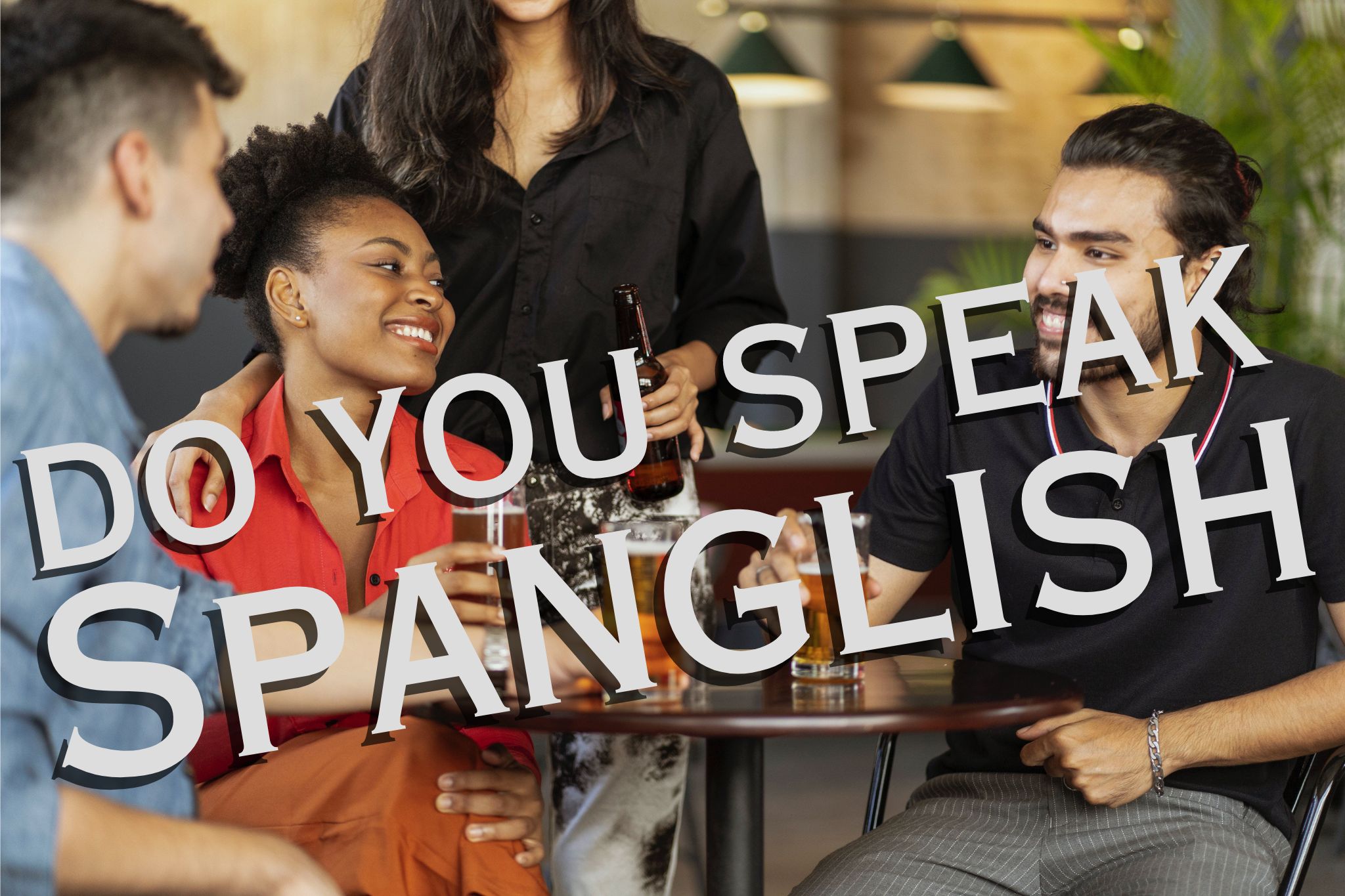¿Hablas Espanglish? Decoding the linguistic fusion of Spanglish

Get our free email course, Shortcut to Conversational.
Have conversations faster, understand people when they speak fast, and other tested tips to learn faster.
More infoHave you ever heard of Spanglish? Or, better yet, have you ever heard Spanglish being spoken? But first of all, what is Spanglish?
In the rich landscape of language, there exists a phenomenon that transcends traditional boundaries of language, weaving together both English and Spanish. This linguistic hybrid, affectionately known as Spanglish or Espanglish, reflects the dynamic cultural interplay between these two languages.
If you’re a Spanish learner, recognizing Spanglish provides a more comprehensive understanding of the language’s real-world applications, while fostering a deeper appreciation for the richness of Spanish language and culture.
With all of this in mind, today we’ll embark on a fun linguistic journey to learn all about Spanglish, including some examples of Spanglish that you may come across in pop culture.
¡Vamos!
Spanglish: origin
The origins of Spanglish are challenging to pinpoint, but it can be traced to the interaction between English and Spanish speakers in areas where English and Spanish speakers coexist, such as The United States, Puerto Rico, and the Dominican Republic.
While not as prevalent, Spanglish can also be found in some Latin American countries where there is exposure to English through media, tourism, or international business.
Spanglish: definitions
So, what is Spanglish exactly? We know that it is a blend of English and Spanish, but is Spanglish a language or a dialect?
Well, it’s a bit more complex than that. Truth be told, there’s not a universal definition of the term, and different communities may use the term “Spanglish” to refer to distinct linguistic practices.
For example, the Spanglish spoken in the United States may differ from that spoken in Latin America. Likewise, within Latin America, different countries and regions may have variations on how they use Spanglish.
In essence, however, what can be considered Spanglish is any linguistic practice in which Spanish and English are mixed in together within the same conversations.
In general, it’s assumed that Spanglish speakers are fluent enough in both English and Spanish that they just choose to use whichever words or phrases from either language when speaking.
Code-switching
This practice of alternating between two or more languages or linguistic varieties within a single conversation or discourse is known as code-switching. In the context of Spanglish, code-switching is the seamless transition between Spanish and English, allowing speakers to incorporate elements of both languages fluidly.
A similar phenomenon is very common in Québec and New Brunswick where a high proportion of the population is fluent in both English and French, resulting in Frenglish.
Now let’s see some examples of Spanglish in action through a dialogue. The first sentences demonstrate our Spanglish examples, while the second ones just show the English-only translations:
– David: Hola, good afternoon, ¿cómo estás? – Hello, good afternoon, how are you?
– Jennifer: Estoy fine, thank you. Aunque me tropecé y tiré mi café a while ago. – I’m fine, thank you. Though I tripped and spilled my coffee a while ago.
– David: No way! ¿Quieres que te acompañe to get another one? – No way! Do you want me to go with you to get another one?
– Jennifer: Sí, please. – Yes, please.
Calques
A related phenomenon involves the literal translation of idiomatic expressions from one language into another. These word-for-word translations, known as calques, don’t normally carry the intended meaning in the second language. In regions where two languages intermingle, however, expressions are sometimes adopted across linguistic boundaries like this.
Can calques be considered examples of Spanglish? Not exactly, but their initial adoption is certainly more common in bilingual regions where a lot of the population tends to use Spanglish. Perhaps calques can be seen more as a “rehispanisation” of anglicisms: speakers choose to use Spanish words rather than Spanglish, even though their meanings are still entirely English!
Let’s see a few examples of Spanish calques that are gradually entering the language from English. Remember that these aren’t universally understood across the Spanish-speaking world, since their use is mostly in regions with strong English influence.
| Spanish calque | original English expression | Standard Spanish expression |
| Llamar pa’atrás | To call back | Llamar de vuelta |
| Pagar pa’atrás | To pay back | Pagar de vuelta |
| Estar pa’arriba de [alguien] | To be up to, To depend on | Depender de |
| Tener un buen tiempo | To have a good time | Pasarlo bien |
| Hacer sentido | To make sense | Tener sentido |
| Correr para presidente | To run for president | Postularse a presidente |
For a funny corollary on this theme of translating expressions literally from one language to another, we recommend our post on Venezuelan expressions that make no sense in English. On the other hand, perhaps Espanglish speakers in Venezuela will understand exactly what you mean if you use these English calques there!
Spanglish in pop culture
Now that we’ve seen our Spanglish definition, as well as the ways that the practice can manifest itself, can you think of instances where you’ve come across Spanglish in real life? If you live in highly bilingual places like Miami, Queens, San Juan, or Panama City, it’s likely that you hear people speaking Spanglish around you on a regular basis. But what about pop culture?
In reality, a lot of big international pop stars these days are fluently bilingual in Spanish and English, so it’s becoming increasingly common for both languages to feature prominently across the cultural landscape of North and South America. Think of such influential singers like Selena Gómez, Shakira, Marc Anthony, Jennifer López, Cardi B, Ozuna, Ricky Martin, Bruno Mars, or Luis Fonsi, among so many others.
To get you in the mood, we’ll end our lesson on Spanglish with an excerpt from an Enrique Iglesias track, Bailando. Even if we don’t translate the Spanish words within the Spanglish verse, you can probably still understand what he’s singing!
I wanna be contigo
And live contigo, and dance contigo
Gotta have contigo
Una noche loca
Ay, besar tu boca
I wanna be contigo
And live contigo, and dance contigo
Gotta have contigo
Una noche loca
Con tremenda nota
Conclusion: Spanglish
¡Felicidades! Did you enjoy our linguistic viaje en espanglish?
Today we saw that even though Spanglish may be difficult to define, it’s a fascinating phenomenon that’s come to life thanks to the interaction between English and Spanish in bilingual communities and through popular culture.
We explored some formal elements of Spanglish, namely the regular jumping between languages known as code-switching, and using direct translations of idiomatic expressions known as calques.
Most importantly, however, we underlined just how important the phenomenon of Spanglish is becoming in our globalized culture across the Americas, as people and languages gradually mix and blend together. So next time you find yourself singing along with the latest hit songs, embrace both languages con tremenda nota!
Enrique Iglesias – Bailando, featuring Sean Paul, Descemer Bueno, and Gente de Zona



